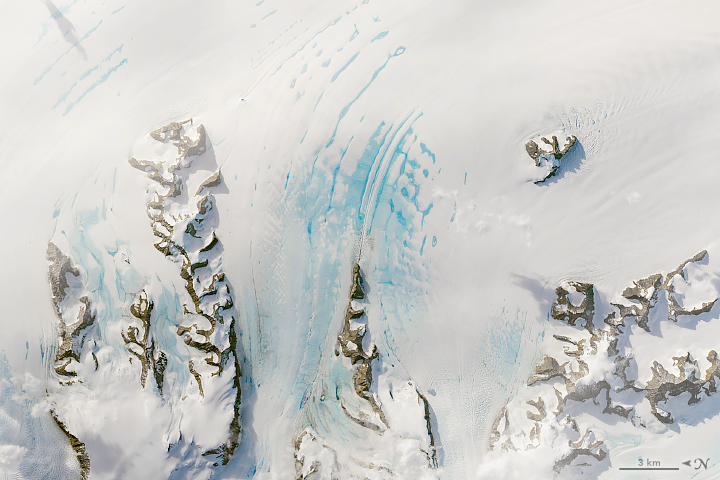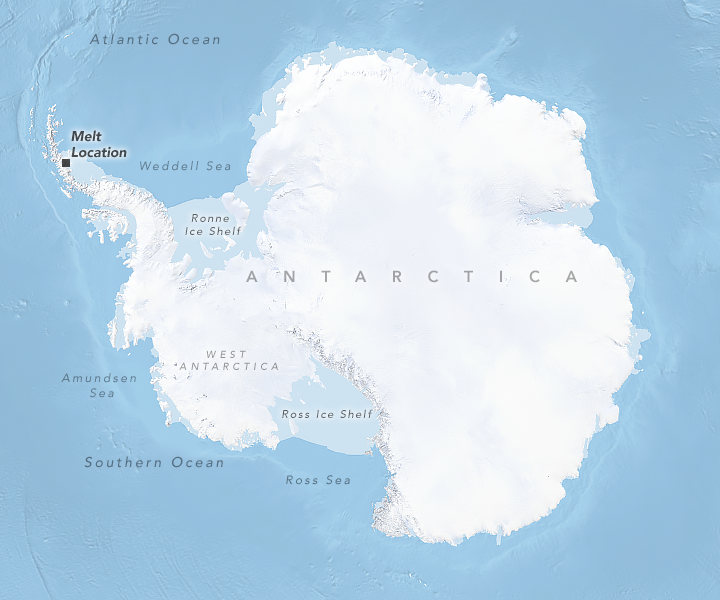New research shows unusual three-year spike in late-season surface melt due in part to bursts of warm, dry wind from Antarctic Peninsula’s mountains
11 April 2019
AGU press contact:
Lauren Lipuma, +1 (202) 777-7396, [email protected]
Contact information for the researchers:
Rajashree Tri Datta, +1 (646) 243-5379, [email protected]
WASHINGTON—The Antarctic Peninsula is the northernmost part of Earth’s coldest continent, making it particularly vulnerable to a changing global climate. Surface melting of snow and ice initiated the breakup of the northernmost Larsen A ice shelf in 1995, followed in 2002 by the Larsen B ice shelf to the south, which lost a section roughly the size of Rhode Island.
New research shows the Larsen C ice shelf—the fourth largest ice shelf in Antarctica, located just south of the former Larsen B shelf—experienced an unusual spike in late summer and early autumn surface melting in the years 2015 to 2017. The new study, spanning 35 years from 1982 to 2017, quantifies how much of this additional melting can be ascribed to warm, dry air currents called foehn winds that originate high in the peninsula’s central mountain range.

This satellite image from March 3, 2016 shows unusual late summer/early fall melting on the Larsen C ice shelf. New research finds the additional melting is due in part to warm, dry air currents called foehn winds that originate in the Antarctic Peninsula’s central mountain range and discusses the compounding effects of these late-season melt events on the snowpack.
Credit: NASA Earth Observatory/Lauren Dauphin.
The study further shows the three-year spike in foehn-induced melting late in the melt season has begun to restructure the snowpack on the Larsen C ice shelf. If this pattern continues, it could significantly alter the density and stability of the Larsen C ice shelf, potentially putting it at further risk to suffer the same fate as the Larsen A and B shelves.
In the new study, researchers used two different methods to quantify patterns of foehn-induced melt from climate model outputs that correspond to real-world satellite observations and weather station data. They published their findings today in AGU’s journal Geophysical Research Letters.
“Three years doesn’t make a trend. But it’s definitely unusual that we are seeing enhanced foehn winds and associated melting in late summer and early autumn,” said Rajashree Tri Datta, a faculty assistant at the University of Maryland’s Earth System Science Interdisciplinary Center and lead author of the new study. “It’s unusual that we’re seeing increased foehn-induced melt in consecutive years—especially so late in the melt season, when the winds are stronger but the temperatures are usually cooling down. This is when we expect melting to end and the surface to be replenished with snow.”

This photograph shows a cloud-clearing, induced by foehn winds, on the lee side of mountains on the Antarctic Peninsula. The photo was acquired during NASA’s Operation IceBridge mission in October 2017.
Credit: NASA/Nathan Kurtz.
Enhanced surface melting causes water to trickle into the underlying layers of firn—or uncompacted, porous snow—in the upper layers of the ice sheet. This water then refreezes, causing the normally porous, dry firn layers to become denser. Eventually, the firn layers can become too dense for water to enter, leading to a buildup of liquid water atop the ice shelf.
“With enhanced densification, the ice enters the next warm season with a very different structure. Our modeling results show that, with less open space for the surface water to filter into, runoff increases year after year,” said Datta, who also has an appointment at NASA’s Goddard Space Flight Center. “The dominant theory suggests that enhanced densification led to the fracture of the Larsen A and B shelves. Despite an overall decrease in peak summer melt over the last few years, episodic melting late in the melt season could have an outsized impact on the density of the Larsen C ice shelf.”

This map shows the location of melting on the Antarctic Peninsula’s Larsen C ice shelf that occurred in late summer and early autumn from 2015 to 2017.
Credit: NASA Earth Observatory/Lauren Dauphin.
As foehn winds race down the colder eastern slopes of the Antarctic Peninsula’s central mountain range, they can raise air temperatures by as much as 17 degrees Celsius (30 degrees Fahrenheit), producing localized bursts of snowmelt. According to Datta, these winds exert their greatest effects at the bases of glacial valleys. Here, where the feet of the glaciers adjoin the Larsen C ice shelf, foehn winds stand to destabilize some of the most fragile and critical structures in the system.
“The Larsen C ice shelf is of particular interest because it’s among the most vulnerable in Antarctica,” Datta said. “Because it’s a floating ice shelf, a breakup of Larsen C wouldn’t directly lead to a rise in global mean sea level. However, the ice shelf does brace against the flow of the glaciers that feed it. So if Larsen C goes, some of these glaciers will be free to accelerate their rate of flow and melt, which will result in a rise in global sea level.”
###
Founded in 1919, AGU is a not-for-profit scientific society dedicated to advancing Earth and space science for the benefit of humanity. We support 60,000 members, who reside in 135 countries, as well as our broader community, through high-quality scholarly publications, dynamic meetings, our dedication to science policy and science communications, and our commitment to building a diverse and inclusive workforce, as well as many other innovative programs. AGU is home to the award-winning news publication Eos, the Thriving Earth Exchange, where scientists and community leaders work together to tackle local issues, and a headquarters building that represents Washington, D.C.’s first net zero energy commercial renovation. We are celebrating our Centennial in 2019. #AGU100
Notes for Journalists
This paper is freely available through May 15. Journalists and public information officers (PIOs) can download a PDF copy of the article by clicking on this link: https://agupubs.onlinelibrary.wiley.com/doi/pdf/10.1029/2018GL080845
Media files accompanying this press release can be downloaded by clicking on the following link:
https://aguorg.sharepoint.com/:f:/s/newsroom/EtbOXqZ0Eg1JlpKssTFdRwUBNwE5E4BqGfxO1miAdVOeTQ?e=A2KdYu
Journalists and PIOs may also request a copy of the final paper by emailing Lauren Lipuma at [email protected]. Please provide your name, the name of your publication, and your phone number.
Neither the paper nor this press release is under embargo.
Paper Title
“The Effect of Foehn-Induced Surface Melt on Firn Evolution over the Northeast Antarctic Peninsula”
Authors
Rajashree Tri Datta: Earth System Science Interdisciplinary Center, University of Maryland, College Park, Maryland, U.S.A., and NASA Goddard Space Flight Center, Greenbelt, Maryland, U.S.A.;
Marco Tedesco: NASA Goddard Institute of Space Studies, New York, New York, U.S.A., and Lamont-Doherty Earth Observatory of Columbia University, Palisades, New York, U.S.A.;
Xavier Fettweis: Department of Geography, Université de Liège, Liège, Belgium;
Cecile Agosta: Université Grenoble Alpes, CNRS, Institut des Géosciences de l’Environnement, Grenoble, France, and Department of Geoscience and Remote Sensing, Delft University of Technology, Delft, Netherlands;
Stef Lhermitte: Department of Geoscience and Remote Sensing, Delft University of Technology, Delft, Netherlands;
Jan T.M. Lenaerts, Nander Wever: Department of Atmospheric and Oceanic Sciences, University of Colorado Boulder, Boulder, Colorado, U.S.A.
Additional press contacts
Matthew Wright, University of Maryland College Park
+1 (301) 405-9267
[email protected]
Patrick Lynch, NASA Goddard Space Flight Center
+1 (301) 286-2102
[email protected]